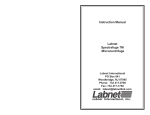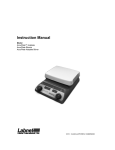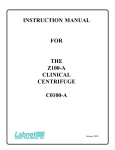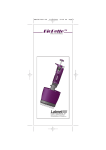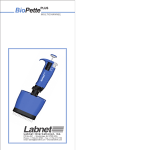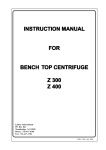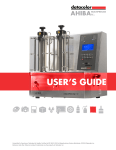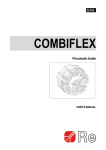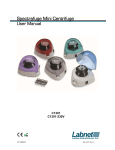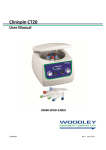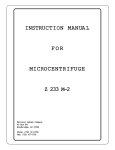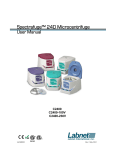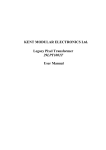Download Spectrafuge 16M Manual - Phenix Research Products
Transcript
Instruction Manual Labnet Spectrafuge 16M Microcentrifuge Labnet International PO Box 841 Woodbridge, NJ 07095 Phone: 732 417-0700 Fax: 732 417-1750 email: [email protected] Safety Precautions NEVER use the centrifuge in any manner not specified in these instructions. NEVER operate the centrifuge without a rotor properly attached to the shaft. NEVER fill tubes while they are in the rotor. Liquid spillage may harm unit. NEVER put hands in the rotor area unless the rotor is completely stopped. NEVER move the centrifuge while the rotor is spinning. NEVER use solvents or flammables near this or other electrical equipment. NEVER centrifuge flammable, explosive or corrosive materials NEVER centrifuge hazardous materials outside of a hood or proper containment facility ALWAYS load the rotor symmetrically. Each tube should be counterbalanced by another tube of the same type and weight ALWAYS locate the centrifuge within easy access to an electrical outlet. ALWAYS use only microcentrifuge tubes made from plastic and designed to withstand centrifugal forces of at least 16,000 xg. Copyright January 2002, Labnet International. All rights reserved. Reproduction without prior written permission is prohibited. Information contained herein is subject to change without notice. Table of Contents 1. General Information Description Safety precautions Technical data Accessories supplied with unit Warranty 1 2. Installation Unpacking the centrifuge Required space Installing the centrifuge 2 3. Installing the Rotor Rotors and accessories Rotor maintenance Mounting and securing the angle rotors Removing the rotor Overloading rotors 3 4. Operation Closing the lid Lid release Lid lock Speed selection Selection of operating time and momentary operation 6 5. Service and Maintenance Service Cleaning Disinfection Replacing fuses 8 6. Troubleshooting 9 7. Where to Call 10 8. Determination of g-values 10 1. General Information This manual provides important safety information for the Spectrafuge laboratory microcentrifuge. It should be kept near the centrifuge for quick and easy reference. 1.1 Description The Spectrafuge is a small benchtop centrifuge designed for separation of various research samples. The motor is brushless and requires no routine maintenance. The Spectrafuge is supplied with an 18 x 1.5ml rotor for micro samples. Adapters are available for tubes smaller than 1.5ml. The Spectrafuge reaches speeds of up to 14,000rpm/16,000 x g. 1.2 Safety precautions Note: All users of the centrifuge must read the Safety Precautions section of this manual before attempting to operate the unit! ! If this equipment is used in a manner not specified by the manufacturer, the protection provided by the equipment may be impaired. Do not operate the centrifuge if any of the following conditions exist: -The centrifuge has not been installed properly -The centrifuge is partially dismantled -Service has been attempted by unauthorized or unqualified personnel -The rotor has not been installed securely on the motor shaft -Rotors and accessories not belonging to the standard range are being used without permission being obtained from the manufacturer to use such rotors and/or accessories in the centrifuge Exception: Microcentrifuge tubes made of plastic, normally available in the laboratory. -The centrifuge is located in an explosive atmosphere -Materials to be centrifuged are combustible and/or explosive -Materials to be centrifuged are chemically reactive -The rotor load is not properly balanced 1 1.3 Technical data Dimensions Width Depth Height 8.25 inches 8.9 inches 7.6 inches Maximum speed 14,000rpm Maximum RCF 16,000 x g Maximum volume 18 x 1.5/2.0ml Admiss. density 1.2kg/dm3 Electrical/fuse rating 120V~, 50-60Hz, 1.0A/2.5AT 230V~, 50-60Hz, 0.6A/1.25AT 1.4 Accessories supplied with centrifuge Each unit is supplied with 1 instruction manual, 1 warranty card and 1 power cord. Some models are supplied with a rotor screw wrench. 1.5 Warranty This centrifuge has been subject to thorough testing and quality control. In the unlikely event of a manufacturing fault, our one year warranty (from the date of delivery) covers the centrifuge and the rotor. This warranty becomes invalid in the case of incorrect operation, use of nonstandard spare parts or accessories and unauthorized modification of the rotor or centrifuge. Labnet reserves the right to make technical modifications. Statements contained herein are not to be considered binding. 2. Installation 2.1 Unpacking the centrifuge Before unpacking the centrifuge, inspect the outside of the carton for any shipping damage. The centrifuge is delivered in a carton with protective cushions. Remove the centrifuge from the carton. Retain the carton and cushions until it has been established that the centrifuge is working properly. Inspect the centrifuge for any visible signs of shipping damage. Shipping damage is the responsibility of the transportation 2 carrier. Any claims for damage must be filed within 48 hours. The accessories supplied with the centrifuge should be kept with the instruction manual near the centrifuge’s place of installation. 2.2 Required space The centrifuge should be installed on a rigid, even surface such as a stable laboratory bench, cabinet, etc. To guarantee sufficient ventilation, ensure that the centrifuge has at least 15cm (6 inches) of free space on all sides, including the rear. The centrifuge should not be located in areas subject to excessive heat such as in direct sunlight or near radiators or the exhaust of a compressor, as a buildup of heat may occur within the chamber. 2.3 Installation Make certain that the timer is set to the off position. Before operating the centrifuge, check that the power source corresponds to that on the manufacturer’s rating label, then connect the power cord to the centrifuge and the power source. ATTENTION: The timer must be in the OFF position before connecting the power cord. Failing to place the timer in the off position may result in damage to the centrifuge and injury to personnel. 3. Installation or rotors and rotor maintenance 3.1 Rotors and accessories The following accessories are available for the Spectrafuge: Angle rotor for 18 x 1.5ml tubes Order no. Included with unit Tube measurement 1.5ml (10 x 40mm) Max. speed 14,000rpm Centrifuging radius 7.3cm RCF (g-value) 16,000 x g Adapter for 0.5ml tubes Order no. Tube measurement Max. speed Centrifuging radius RCF (g-value) C-1205 8 x 30mm 14,000rpm 6.6cm 14,462 x g 3 Adapter for 0.4ml tubes Order no. Tube measurement Max. speed Centrifuging radius RCF (g-value) C-1206 6 x 47mm 14,000rpm 7.3cm 16,000 x g Adapter for 0.2ml tubes Order no. Tube measurement Max. speed Centrifuging radius RCF (g-value) C-1222 6 x 21mm 14,000rpm 6.1cm 13,366 x g 3.2 Rotor maintenance The rotor should be cleaned thoroughly after each use. Thorough cleaning must be performed when spinning samples containing phenol or phenol chloroform. Periodically inspect the rotor for dents, dings, scratches, discoloration and cracks. If any damage to the rotor is found, discontinue use of the rotor immediately and replace. 3.3 Mounting and securing the angle rotor Remove the rotor screw from the motor shaft by turning the screw counterclockwise. Clean the motor shaft and the rotor mounting hole (see figures 1&2). Place the rotor on the motor shaft ensuring that the cross-pin (figure 1) aligns correctly with the rotor slot (see figure 2). Note: Figures 1 and 2 are located on the following page. Reinstall the rotor screw on the motor shaft by turning it clockwise. Hold the rotor with one hand and hand-tighten the rotor screw. Use an adjustable or 1/4 inch wrench (some units are supplied with a wrench) to tighten the screw an additional quarter turn. When loading the rotor, refer to figure 3 (located on page 5). Loading in the pattern indicated will ensure a balanced load. Tubes to be loaded should be filled equally by eye. The difference in the weight between the tubes should not exceed 0.1 gram. A partially loaded rotor may be centrifuged if the loading scheme for balancing a rotor given in figure 3 is followed. 4 Figure 1. Chamber and motor shaft Figure 2. Bottom of angle rotor Figure 3. Loading the rotor 5 3.4 Removing the rotor Using an adjustable or 1/4 inch wrench (some units are supplied with a wrench) loosen the screw and remove the rotor retaining screw/washer assembly by turning it counterclockwise. Lift the rotor directly upward in a straight vertical motion. Caution: Be sure to secure the rotor screw and tighten with a wrench before further operation. 3.5 Overloading rotors The maximum load of the rotor and the maximum speed have been established by the manufacturer. Do not attempt to exceed these values. The maximum speed of the rotor has been measured for liquids having a homogeneous density of 1.2g/ml or less. In order to centrifuge liquids with a higher density it is necessary to reduce the speed. Failure to reduce the speed may result in damage to the rotor and centrifuge. The revised maximum speed can be calculated with the following formula: Reduced speed (nred) = 1.2 higher density value x max speed (nmax) Example: Where the density of the liquid is 1.7, the new maximum speed would be calculated as follows: nred = 1.2 1.7 x 14,000 = 9,882 rpm If in doubt concerning maximum speeds, please contact the manufacturer for assistance. 4. Operation ATTENTION: Never attempt to operate the centrifuge with rotors or adapters that show signs of corrosion or mechanical damage. Never centrifuge strongly corrosive materials that may damage the rotors or accessories. 4.1 Closing the lid After the rotor has been properly secured and loaded, close the centrifuge lid, making sure that the interlock has been engaged. 6 Figure 4. Spectrafuge control panel layout 4.2 Lid release Once the run has been completed and the rotor come to a stop, the lid will open automatically. If the lid does not open automatically, press the lid button. Note that the lid button will not operate while the rotor is spinning. WARNING: Do not attempt to open the lid of any centrifuge until the rotor has come to a complete stop. In the event of a power failure or malfunction, it may be necessary to open the lid manually. 1. Disconnect the power cord from the wall socket. 2. Remove the plastic plug, located on the left side of the unit, below the quick button. 3. Pull the cord (attached to the plug) to open the lid lock manually. 4.3 Lid lock The centrifuge can be started only with the lid securely closed. When the rotor begins to accelerate, the lid lock indicator light turns on and the lid button becomes inoperable. Do not attempt to open the lid until the lid lock indicator turns off. At the end of the run, the lid will automatically open. 4.4 Speed selection The speed (rpm) can be selected to 14,000rpm with the knob labeled “speed”. The scale is directly proportional to the speed a setting of 9 corresponds to 9,000rpm, a setting of 13 corresponds to a speed of 13,000rpm, etc. 7 4.5 Selection of operating time and momentary operation Operation of the centrifuge begins when the timer knob is turned clockwise to set a run time. For run times less than 5 minutes, turn the knob clockwise past the halfway point and then counterclockwise to the desired time. For run times longer than 5 minutes, turn the knob clockwise to the desired time. When the preselected time expires, the centrifuge will stop automatically. To stop the centrifuge prior to the expiration of set time, turn the timer knob to the zero position. The centrifuge may be operated manually by pressing and holding the quick button. The centrifuge will continue to run as long as the button is depressed. Some models are equipped with a timer that includes a hold position. Continuous operation of these models may be achieved by turning the timer knob firmly to the left. The centrifuge will continue to operate until the knob is turned to the zero position. Note: The timer knob may be turned in either direction during operation of the centrifuge without damage to the timer mechanism. 5. Service and Maintenance 5.1 Centrifuge service The brushless motor in the Spectrafuge 16M requires no routine maintenance. Any required service should be performed by authorized, qualified personnel only. Repairs performed by unauthorized personnel may void the warranty. 5.2 Cleaning the centrifuge Always keep the centrifuge housing, rotor chamber, rotor and rotor accessories clean. All parts should be wiped down periodically with a soft cloth. For more thorough cleaning, use a neutral cleaning agent (pH between 6 and 8) applied with a soft cloth. Excessive amounts of liquid should be avoided. Liquid should not come into contact with the motor. After cleaning, ensure that all parts are dried thoroughly by hand or in a warm air cabinet (maximum temperature 50ºC) 5.3 Cleaning the rotor The rotor should be cleaned after each use. When spinning 8 samples containing phenol or phenol chloroform, the rotor should be cleaned immediately after use. 5.4 Disinfection Should a spill of infectious materials occur within the rotor or chamber, the unit should be disinfected. This should be performed by qualified personnel with proper protective equipment. 5.5 Replacing fuses Check the fuse when it is recommended in the Troubleshooting Guide located in this manual. The fuse holder is located in the power inlet on the rear of the unit. Disconnect the power cord from the power inlet. Open the fuse holder drawer by inserting a small screwdriver under the tab and prying it open. Remove the innermost (operative) fuse from its retaining tabs and replace the fuse if necessary. A spare fuse is located in the outermost chamber of the fuse drawer. Replace only with a fuse of exactly the same value as the original. (Fuse type may be found in the Technical data section of this manual.) 6. Troubleshooting Guide Please refer to this guide before calling for service. Centrifuge will not start Possible reason: Solution: No power supply Check that power is being supplied to the outlet Check that the power cord is plugged into both the wall outlet and the back of the centrifuge Check that power cord is not damaged Possible reason: Solution: Blown fuse Check fuse and replace if necessary Lid lock will not release Possible reason: Solution: Defective lid lock Open manually and have unit serviced Possible reason: Solution: No power from PC board Call for service Possible reason: Solution: Lid lock is jammed Call for service 9 Possible reason: Solution: Centrifuge is not receiving power See “Centrifuge will not start” Centrifuge cannot be started, although power is on Possible reason: Solution Lid not closed correctly Close lid correctly Possible reason: Solution: No speed or time has been selected Set speed and/or time 7. Where to call Should you have any questions about the Spectrafuge or its accessories, please call Labnet’s Customer Service Department at 732 4170700. Customer Service is staffed from 8:30am to 5:30pm, EST, Monday through Friday. Our 24 hour fax number is 732 417-1750. Inquiries may also be sent via our electronic mailbox at [email protected]. Should your Spectrafuge require service, please call Labnet’s Technical Services Department at 732 417-0700. Our Service Department is staffed from 8:30am to 5:00pm, EST, Monday through Friday. Our 24 hour fax number is 732 417-1750. Electronic mail may be sent to [email protected]. Please have the unit’s serial number (located on the back panel of the instrument) available when calling. Should an item require return to Labnet for service, a repair return authorization (RRA) number must first be received from Labnet. Items sent without an RRA number will not be accepted. 8. Determination of g-values The centrifuging radius of the 1.5ml rotor is 7.3cm. See Section 3.1 for the correct radius when using adapters and smaller tubes. The chart on the next page can be used to determine g-values. 10 To use this chart, find the radius value on the radius scale. Place the edge of a ruler on the value. Place the right side edge of the ruler on the speed scale at the desired speed. The estimated RCF can then be read from the RCF scale where the ruler edge passes through it. This chart can also be used to determine the proper speed for the desired RCF value. 11 Notes
















